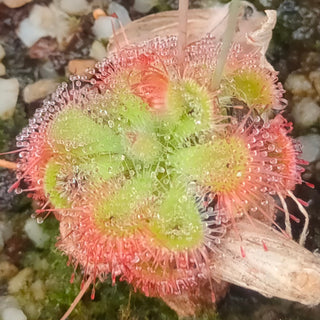Gaultheria procumbens
WINTERGREEN AMERICAN, CHECKERBERRY, TEABERRY, BOXBERRY
- Unit price
- / per
Traditionally grown as a groundcover, and an excellent ornamental for winter holidays and container specimens. The bright red wintergreen-scented berries with glossy green leaves. Native to northeastern North America from Newfoundland west to southeastern Manitoba, and south to Alabama.
G. procumbens is a small, low-growing shrub, typically reaching 15 cm (6") tall. The leaves are evergreen with a distinct oil of wintergreen scent.
The flowers are pendulous, with a white, sometimes pink-tinged, and bell-shaped.
The plant is a calcifuge, favoring acidic soil, in pine or hardwood forests, although it generally produces fruit only in sunnier areas.
This plant was received the Award of Garden Merit (A.G.M.) from the Royal Horticultural Society.
Type: Low-growing shrub
Hardiness zones: 2-8
Height: 15cm, 6"
Location: Indirect sun, part shade
Seeds per pack: 15
Sow just under the surface of the soil and water in. Leave them at room temperature for 6 weeks. This helps break the phytohormones which inhibit germination. They will not grow yet. Then a cooling period is required. Cover them with plastic and place in a fridge for 80 days. Be sure they stay moist. After the cold stratification period they are then brought back to a cool room (15-18C, 59-68F) for them to germinate. Germination can be erratic, generally 30-90 days after the warming period for most seeds, though some can take longer.
Gaultheria procumbens
WINTERGREEN AMERICAN, CHECKERBERRY, TEABERRY, BOXBERRY
- Unit price
- / per
Multiple secure payment options available.
Adding product to your cart
You may also like
Traditionally grown as a groundcover, and an excellent ornamental for winter holidays and container specimens. The bright red wintergreen-scented berries with glossy green leaves. Native to northeastern North America from Newfoundland west to southeastern Manitoba, and south to Alabama.
G. procumbens is a small, low-growing shrub, typically reaching 15 cm (6") tall. The leaves are evergreen with a distinct oil of wintergreen scent.
The flowers are pendulous, with a white, sometimes pink-tinged, and bell-shaped.
The plant is a calcifuge, favoring acidic soil, in pine or hardwood forests, although it generally produces fruit only in sunnier areas.
This plant was received the Award of Garden Merit (A.G.M.) from the Royal Horticultural Society.
Type: Low-growing shrub
Hardiness zones: 2-8
Height: 15cm, 6"
Location: Indirect sun, part shade
Seeds per pack: 15
Sow just under the surface of the soil and water in. Leave them at room temperature for 6 weeks. This helps break the phytohormones which inhibit germination. They will not grow yet. Then a cooling period is required. Cover them with plastic and place in a fridge for 80 days. Be sure they stay moist. After the cold stratification period they are then brought back to a cool room (15-18C, 59-68F) for them to germinate. Germination can be erratic, generally 30-90 days after the warming period for most seeds, though some can take longer.


















































